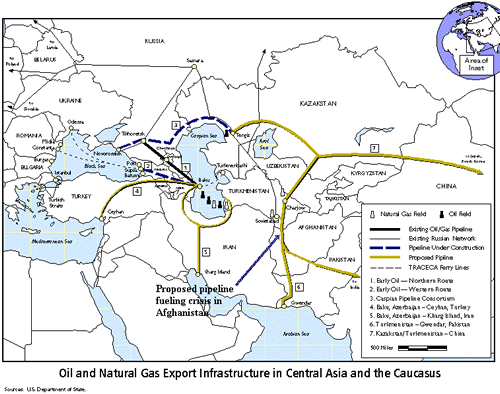| Deep Geo/Political Implications of Peak Oil | ||
 |
||
| This map shows the plans for the trans-Afghani pipeline which is being vigorously pursued by the world's largest oil companies. Prior to the war in Afghanistan, these companies had already invested hundreds of billions of dollars in cash into the Caspian Sea region; however, because of the reluctance of the Taliban to negotiate a deal for the pipeline, the oil companies had no way of getting the oil to the markets. Now
that the U.S. has invaded Afghanistan and created a puppet
government, the prime minister of which previously worked for
UNOCAL, the plans for the construction of the pipeline are
being implemented. However, recent reports suggest that the
oil reserves in the Educate yourself about the |
s | |
|
"Impressed
by the ruthlessness and willingness of the then-emerging Taliban
to cut a pipeline deal, the State Department and Pakistan's Inter
Services Intelligence agency agreed to funnel arms and funding
to the Taliban in their war against the ethnically Tajik |
||
This project of supporting the Taliban in order to secure access to a Trans-Afghani Oil pipeline continued until around the summer of 2001, when the relationship between the Taliban and the U.S. began to seriously unravel. Amid fears of the major oil companies that continued investment in the Taliban regime might not pay off, the U.S. government began to pursue the military option. |
||
|
"The
U.S. government hoped, despite a declining relationship with the
regime, that the Taliban would be 'a source of stability in Central
Asian that would enable the construction of oil pipelines across Confronted with the Taliban's refusal to accept U.S. conditions, "this rationale of energy security changed into a military one. At one moment during the negotiations, the U.S. representatives told the Taliban, either you accept our offer of a carpet of gold, or we bury you under a carpet of bombs." 3 Former Pakistani Foreign Secretary, Niaz Naik, stated that according to information passed to him by U.S. officials in July 2001, "Washington would launch its operation from bases in Tajikistan, where American advisors were already in place" and "Uzbekistan would also participate in the operation . . . 17,000 Russian troops were on standby." He was also told that "if the military action went ahead it would take place before the snows started falling in Afghanistan, by the middle of October at the latest." 4 "Right
around September 11, two |
||
|
1. Ahmed, Nafeez Mosaddeq. The War on Freedom. Media Messenger Books. 2002 2. Godoy, Julio. U.S. Taliban Policy Influenced by Oil. Inter Press Service. 16 November 2001 3. Brisard, Jean-Charles and Dasquie, Guillaume. Bin Laden, la verite interdite. Denoel Impacts, Paris. 2001 4. Arney, George. 'U.S. "planned attack on Taleban".' BBC News. 18 Sept. 2001 5. Cited in Ruppert, Michael, A Time For Fear. From The Wilderness. Oct. 2001. |
||
 |
||